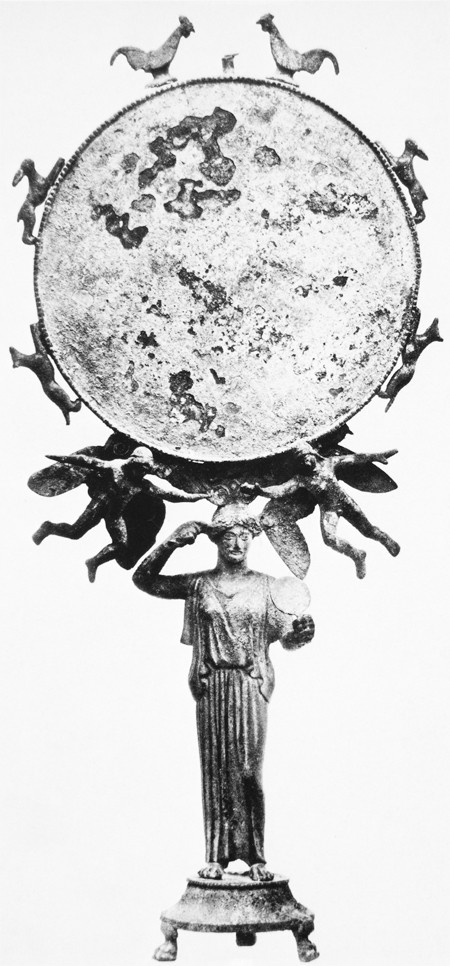An ancient Greek bronze mirror formerly in the Herzoglisches Museum Gotha was among the thousands of objects that went missing from German collections in the wake of World War II. Although many were later recovered, the fate of the Gotha mirror was unknown until 2005, when it reappeared in Moscow at the Pushkin Museum. My study takes the form of an object biography in which I trace the “life history” of the mirror from its production in the fifth century BCE through its discovery in the nineteenth century—and its disappearance in 1945 and rediscovery in the twenty-first century. Such a holistic approach to the analysis of a single object elucidates important information about ancient Greek technology and trade, the social functions of mirrors and ideologies of gender, and issues surrounding modern historiography and cultural heritage.
The life of the Gotha mirror began with the mining of ores, which required extensive human and natural resources. The copper, tin, and lead were likely smelted in close proximity to the mining site and formed into ingots. These would have been transported via extensive trade networks to the individual workshops where they were melted down and combined to create bronze alloys. Caryatid mirrors like the Gotha example are complex objects that required multiple metallurgical techniques in their construction. The individual elements would have been cast separately using the lost-wax process and assembled by means of various mechanical and metallurgical joins, including the use of rivets and soldering. The reflective surface was likely achieved using scraping and burnishing tools followed by increasingly fine abrasives. Clearly ancient Greek mirrors embody an exceptional degree of technical knowledge, passed down through generations of anonymous workers.
The Gotha mirror, made by low-status male metalworkers, was likely purchased by an elite man who in turn presented it as a gift to a woman. Metal objects were typically gendered masculine in Greek society; hence, the exchange and consumption of ancient Greek mirrors resulted in a “regendering” of this unique type of metal object. During its use-life, the mirror was essential for the performance of the feminine toilette, especially hairstyling. As valuable symbols of ideal femininity and wealth, mirrors were frequently dedicated in sanctuaries and buried with the dead.
Although we do not know the depositional context of the Gotha mirror, we can say that its “afterlife” began in the nineteenth century when it appeared on the antiquities market. The mirror was part of the esteemed collection of bronzes sold by the French antiquarian Julien Gréau (1810–1895) at the Hôtel Drouot in Paris in 1885. The catalog for the sale, produced by Wilhelm Fröhner (1834–1925), a former curator of antiquities at the Louvre, constitutes the earliest documentation for the object. Number 609 in the catalog, identified as a “
With the increasing instability of the war years, the Herzoglisches Museum was closed, and the most important objects were placed in storage for safekeeping. Despite such precautions, the Gotha collections were devastated during the war and the Soviet and American occupations. The Gotha mirror was declared lost. Although thousands of objects were returned by the Soviet Union in 1958, the mirror was not among them.
In the course of my research at CASVA, I discovered that the Gotha mirror had survived in the Pushkin Museum in Moscow. In 2005 the museum mounted an exhibition entitled The Archaeology of War: Return from Nonbeing, in which antiquities “rescued” by Soviet soldiers in 1945 were displayed for the first time. Number 53 in the exhibition catalog is clearly the caryatid of the Gotha mirror, though without the miniature mirror in her hand; the Erotes are listed separately, as numbers 168 and 169. The reflective disk and attachments are not included in the catalog. Perhaps in the course of
